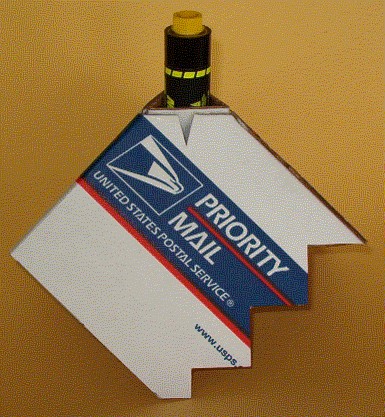Scratch 29mm Priority Stealth Original Design / Scratch Built
Scratch - 29mm Priority Stealth {Scratch}
Contributed by Art Applewhite
| Manufacturer: | Scratch |
Brief:
This 29mm odd roc is entirely constructed from a corrugated cardboard box.
Plans can be downloaded from the Art Applewhite Rockets web site for free. It
is very inexpensive and easy to build, requiring only white glue, a sharp craft
knife, a ruler, ball-point pen, and packing tape to complete.
Construction:
All you need is a 6" x 6" x 5" Priority Mail box or similarly
sized, corrugated cardboard box. There are only 3 parts, the Top, Bottom and
Motor Mount. The rocket can be flown on any 29mm Ellis Mountain, Roadrunner, or
Aerotech single use F or G motor or any Aerotech RMS 29/40-120 or RMS 29/60
reloads.
First download the PDF pattern file from the Art Applewhite Rockets web site. The pattern has 2 pages. There are also 3 pages of more detailed instructions on the web site.
Start by folding the box flat with the overlapped seam facing up. Cut the box in two equal halves using the edge of the seam as a guide. Save the right half of the box for later. Cut the bottom two flaps off at the fold and cut the upper right flap off 1/2" above the fold. Take the flap you just cut off and tape it to the end of the upper left flap with some wide clear packing tape. Flip the panels over and run a fillet of glue on the inside seam of the third panel then lay it flat to dry.
Cut the side pattern from the plans and place it on the lower right panel of the box. Trace around the pattern with a ball point pen. Rotate the pattern 90 degrees and move it to the lower left panel and trace around it again except for the launch rod notch. Rotate the pattern 90 degrees clockwise again and place it on the remaining panel and trace around it. Note that this last panel is a little short on the right edge so the pattern will stick a little over that edge when lined up with the others.
Cut around the outline with a sharp craft knife and a ruler. Fold the panels into a corner shape and glue the 1/2" flap to the inside of the panel. You can lay a strip of clear tape on the outside surface of this seam to improve the aerodynamics.
Glue the Bottom pattern to the middle of one sides of the box that was set aside at the beginning. Cut out the Bottom and place it inside the TOP. It should lay flat against all three side of the Top with the launch rod holes lined up. Put a heavy fillet of glue around all three edges of the Bottom. Repeat as needed to make a strong joint.
Glue the Motor Mount pattern to one of the left over box flaps. Cut it out and crease the fold lines with a ball point pen and a ruler. Fold the Motor Mount into a triangle shaped tube and hold it together with a strip of wide tape on the inside. Don't worry about keeping the side with the joint flat, the next step will take care of that.
Insert the Motor Mount into the triangular hole in the Bottom. Make sure the seam in the Motor Mount is not lined up with the launch rod hole. Push the Motor Mount up until it just stick out the Top. Put a fillet of glue around the Motor Mount where it joins to the Top and Bottom.
Finishing:
You can finish the rocket in any way you want. If you use a Priority Mail box
you can simple spray it with a couple of coats of clear paint to protect the
cardboard and glue from moisture.
Flight:
There is a long list of recommended motors. Basically any 29mm F or G motor and
most 29mm reloads can be used. All you have to do to prepare this rocket for
launch is to remove the ejection charge and slide the motor into the motor
mount. Since the top end is open, a light friction fit is all that is required.
If the motor lacks an aft thrust ring one can be made with a few wraps of
masking tape. It was flown twice as NSL 2006. First on an Ellis Mountain G35
that seemed to burn forever and next on the new Road Runner G80-4R. The crowd
loved both flights. The flights were low but not too slow and it was recovered
close to the pad with absolutely no damage both times.
Recovery:
Recovery couldn't be easier. The rocket uses helicopter or auto rotation
recovery. It rotates as it descents slowly with any of the recommended motors.
Summary:
This rocket is a great addition to any fleet. It is cheap and quick to build
and flies well in all kinds of weather conditions and fields. It is rugged and
goes where other 29mm rockets fear to tread.
Sponsored Ads
 |
 |












